You may – or more likely, may not – remember back in 2019 I started a series called Before It Burns Down, which is a very tasteless title for my plan to visit all the cathedrals, after having realised when Notre-Dame caught fire that these medieval behemoths might not actually sit and wait for me to visit them. I did Winchester, Salisbury, Canterbury, York and St Paul’s in relatively quick succession but my plans to get the lot done were scuppered, not by fire but by plague. Which is fittingly biblical, I suppose.
Actually, I visited Wells Cathedral in that first month too but I only took a few photos and they were on my phone so I never did a post about it. I went back this weekend and now we’re ready to go!
I spent most of last Friday in the cathedral. That’s partly because I visited it by myself, then I joined the walking tour, followed by the outside tour but also, it was very hot and an ancient stone cathedral is a giant medieval fridge.
Most of the medieval cathedrals I’ve visited so far were originally built in the Norman style in William the Conqueror’s 1070s cathedral-building splurge. Only a century later, people started to go “That Gothic style they’re using in France is nice. Can we have that?” and so cathedrals were rebuilt in Gothic, except at the time they called it “the French style”. Some, like Salisbury, were demolished and rebuilt from scratch. More commonly, like Winchester, they were slowly rebuilt starting at one end and finishing at the other, bay by bay. Winchester is actually a great example because you can literally see where the money ran out – the transepts are still Norman and so is the crossing tower. It’s a living breathing archaeological dig. If you take the underground tour at York Minster, you can see the remains of the Norman cathedral and the remains of some older stuff too and that’s very interesting.
Wells doesn’t have any of that. Wells was purpose-built in the Gothic style starting in the 1170s. Of course, there’s been assorted churches, cathedrals and places of worship on the site since at least Roman times but the pre-existing churches were all demolished and the current Gothic cathedral actually isn’t a replacement for/rebuilding of a Norman leviathan, which is unusual in the cathedrals I’ve visited so far. It’s the Early English style of Gothic and you can see the Norman inheritance in it in that it’s quite plain and solid and undecorative. The eastern end of the quire is later than the western end and it’s visibly more ornate, as are the later chantry chapels. York, which is a later Gothic style, is very different – much more elaborate, much more spiky and extra. Wells has the pointed arches and the three-layer system and the massive pillars are made to look like clusters of slim delicate ones but most of it is a very plain early kind of Gothic that looks like Norman restyled into a different shape.
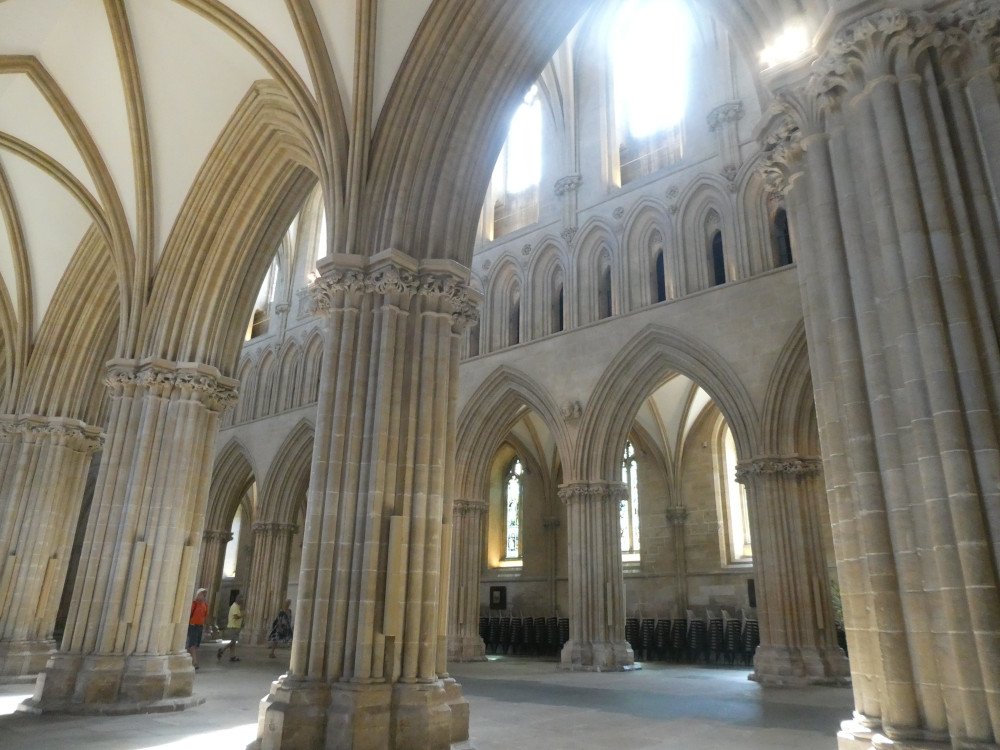
On the other hand, it does have the most spectacular west front. It’s not my sort of thing – I actually quite the plainer style – but I think what I dislike about the west front is less the excessive style, and it is – spikes and niches and decorative columns and capitals and all sorts – and more that it’s kind of cliff-like and monolithic. And I like cliffs. I think Lincoln’s is even bigger. I guess it’s imposing and it kind of says “my God will smite you, unbelievers!” but as I said, it’s not for me.

Inside is a different story, however. It’s so light and bright and modern-looking that the first time I came here I had to go home and do the reading to realise that this is medieval. That’s mostly thanks to the pale stone and the unique architecture in the crossing. The famous scissor arches. The scissor arches are amazing. They’re not an original feature but they were added in the mid-14th century to brace the crossing piers. To put it another way, they extended the tower in the middle because what kind of bishop is going to live with a short squat tower? It was far too heavy for the columns to support its weight and the whole cathedral was threatening to collapse. To this day, the tower is full of the massive cracks that appeared once it was put up. These odd-looking arches, three on top of each other, nose to tail to tail to nose, look very light and slender and modern but are in fact both very old and very strong. You’d have to have a heart of stone to not adore these scissor arches if there’s the faintest Gothic church architecture fan lurking inside you.


As for the pale stone, that was once painted in the most incredible patterns, mostly in blue and red. But during the Reformation, decorations and in particular faces were disapproved of so the whole thing was limewashed. Later restorers chipped the limewash off because they thought the painting should be shown but between the lime, the chipping and the washing, almost the whole lot got destroyed. There’s a hint in the north transept and they found just enough to recreate some of the patterns on the ceilings but once this whole building would have been a riot of colour.
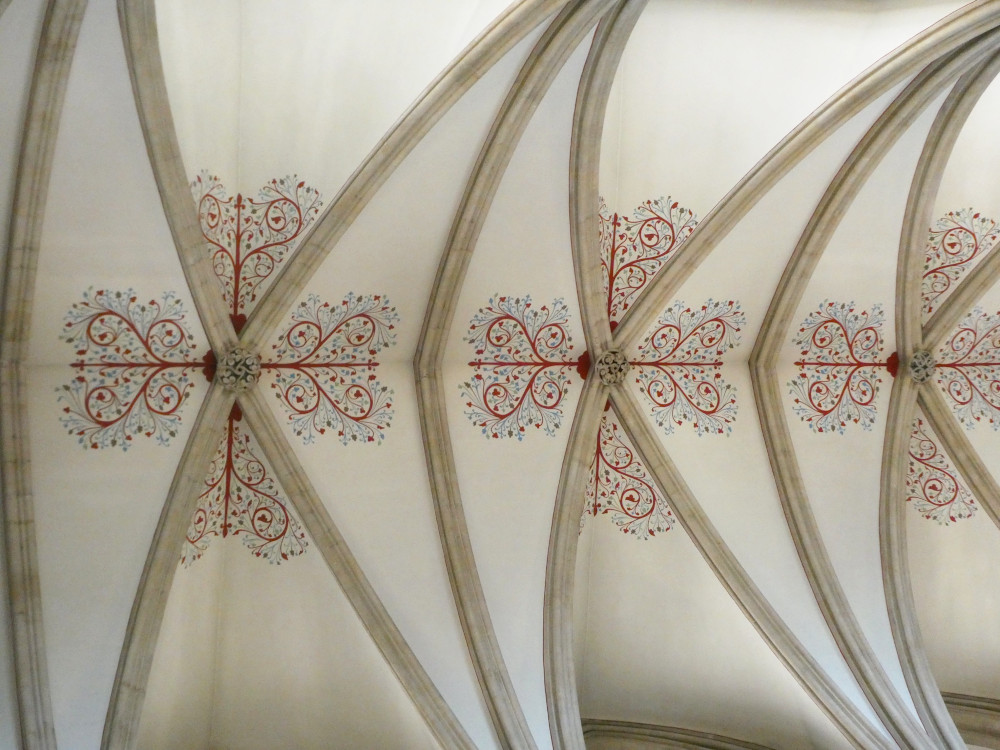
What else have we got? Well, the chapter house is pretty special. They’re meeting rooms, really, but because they’re in cathedrals, they have to be a bit… well, extra. Wells’ is a kind of fan vaulted Gothic style that looks to the modern eye like soaring palm trees. You reach it via one of the most characterful staircases in the world, ancient stone that’s worn down and very uneven. How long have people been walking up and down these stairs? Oh, more than 600 years. Some of the oldest stained glass in the cathedral is in the west side of this staircase – medieval glass is fragile and cathedrals were heavily targeted by Parliamentary troops during the Civil War. Winchester, to harp on about my beloved, gathered up the fragments and used them not to put the windows back together, exactly, but to make a rainbow mosaic out of the destruction. Wells got off reasonably lightly. It does have a few mosaic windows in the Lady Chapel but it also has at least ten 600+ year old windows and one is the large Golden Window at the east end of the choir, which used a new technique where they used a lot of yellow. I don’t really understand the new technique but it’s a pretty window and it survived the Civil War, probably because it was impossible to throw things through from the ground.


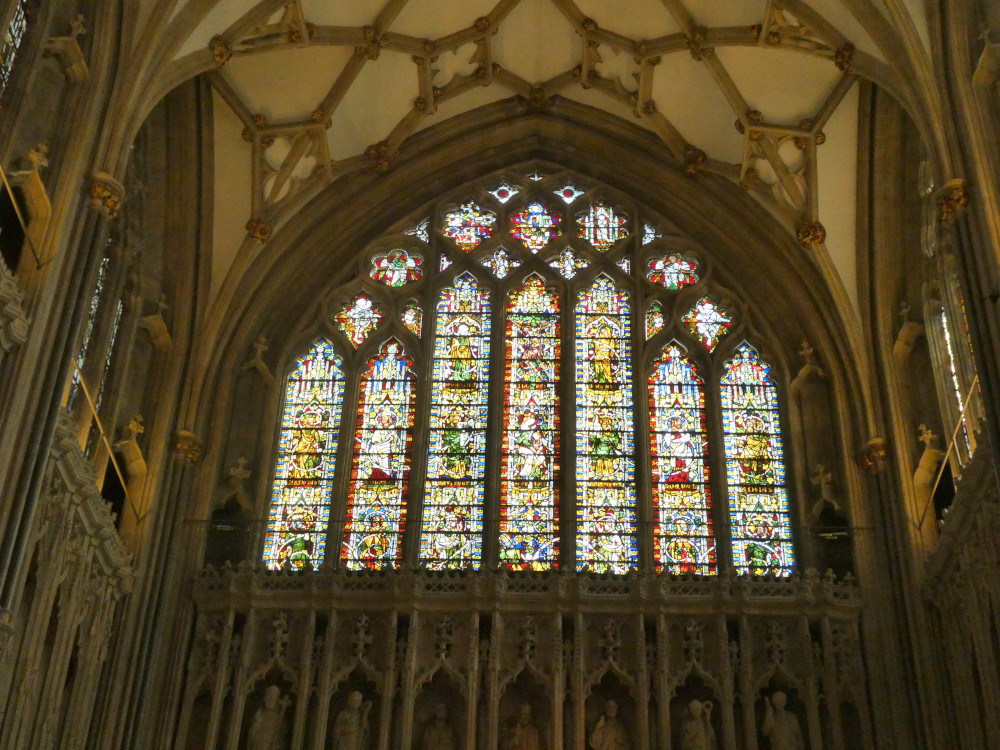
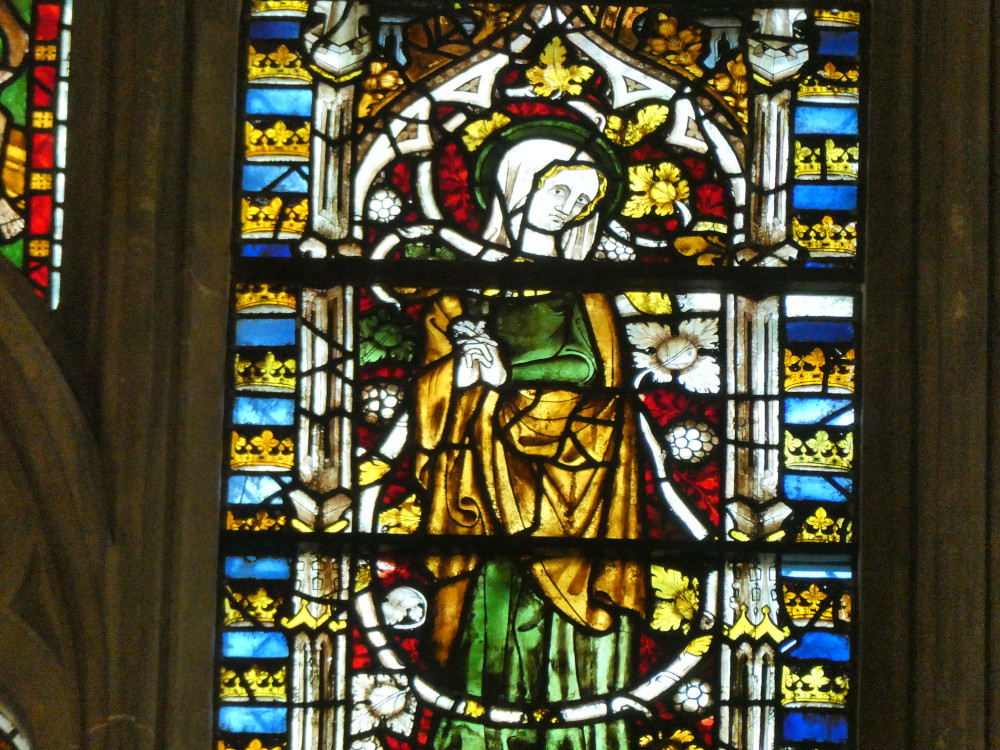
And the other thing is the chained library. Books were expensive and valuable so they were literally chained to the shelf to protect them from theft or just from careless borrowers who forgot to return them. These days there aren’t many chained libraries left. Wikipedia notes fourteen, of which all except two are in England, three are in Somerset and another is just down the road in my neck of the woods in Wimborne. My dad and I stuck our heads in back in 2019 to find a very enthusiastic volunteer who wouldn’t let us in, since it isn’t really open open to the public but let us lean through the door and take photos and explained just how very old some of the books are. This weekend, it was just plain closed. There’s a Chained Library tour and I did try to book it but it was sold out.
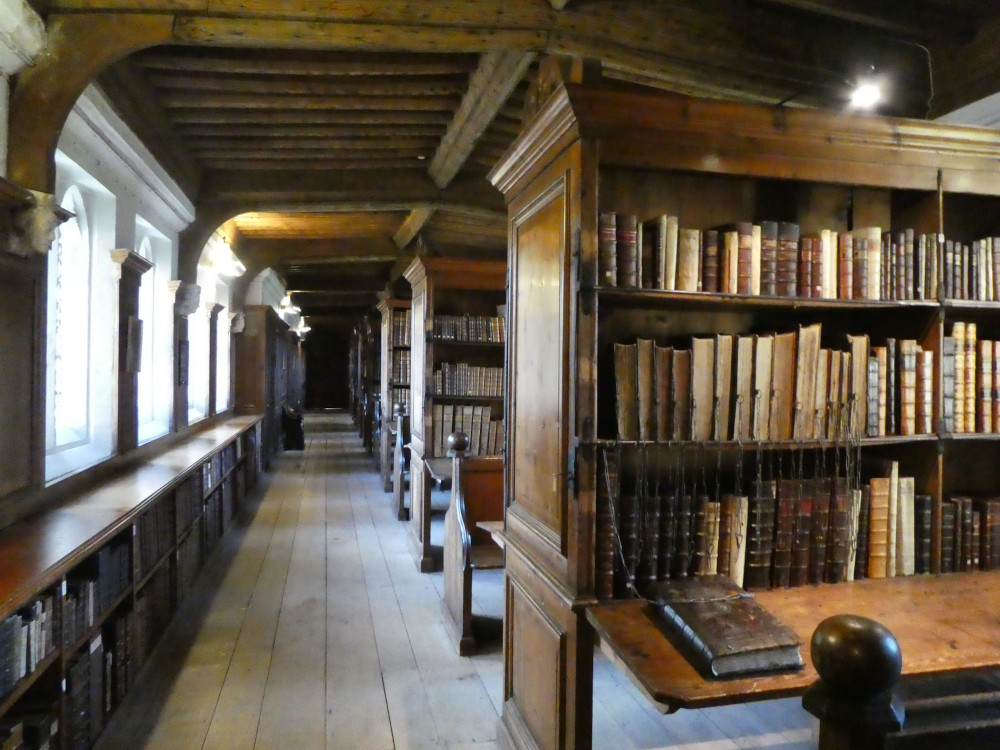
Back outside, over the road, is Vicars’ Close, which claims to be the oldest “purely residental street in Europe”. It’s very pretty, very old-fashioned English.

Now, this one did have a tour available! That is, the Guided Tour of the Outside of Wells Cathedral included the Close along with a guide to the exterior of the cathedral itself. I’ve done high places tours before. I’ve done low places tours before. I’ve never done a tour that’s specifically for the outside. Because of the heatwave, our guides considered cancelling this – you just can’t walk around outside for an hour in this kind of weather. But in the end, they modified it and we got the exclusive limited edition Inside Outside Tour, which meant nipping in and out of the cathedral and using doors that the public don’t often use, which was in itself exciting. It’s something of an Easter egg tour – here are lots of carved things stuck on the building that you wouldn’t notice, like the head of an 80s master mason hidden on the back of the Chapter House. He has a flat cap and big black glasses and you weren’t supposed to put faces on the cathedral at the time, so he hid it and it was a surprise a few years later to uncover him. Here’s the story of a murdered Saxon king hidden in the capitals of a pillar outside. Here’s where a bishop put his name in code in the cloisters to make sure we were still talking about him nearly six hundred years after his death.


We saw the remains of the older churches, and the remains of a newer chapel off the side that was demolished – so preoccupied with following the lines of older digs that it never crossed my mind to ask why that later chapel was removed. We went into the North Porch and looked at the other side of the exterior. We sneaked out the back door of the Lady Chapel (the American tourists I was with asked if the Lady Mary in question was the mother of Henry VIII or of his son or someone like that and the poor guide had to explain that this is a far older building than that and it’s a religious building and the Lady Mother Mary was… well, you know, the mother of this guy the church thinks is quite important called Jesus?) Anyway, there’s a small door in the Lady Chapel that leads to a short passage inside the hefty walls and a second small door that takes you to the far end of the garden where we’d looked at the remains of the older churches.

We looked at buttresses and flying buttresses and yew trees used to replace non-native palm trees which don’t generally flourish in the West Country. We looked at narrow windows in the cathedral and huge windows with later Gothic surrounds in the cloisters and our guide explained that you could take out every single wall in the place and it would all stay standing because of the strength in the buttresses. We compared the newer bits to the older bits. We were reminded of every step by our second guide who might have made an excellent second guide but made an infuriating voice of health and safety.

We saw Vicar’s Close, which was built as a gilded cage for the choristers so they didn’t have to go into the city where they might meet temptations like scarlet women – they lived here, they had a kind of shared kitchen/refectory here and a covered pathway directly into the cathedral and if you look closely, it’s covered in more Easter eggs. Here’s the sign of Bishop Beckynton, who did a lot of work for the cathedral during his time, who built the culverts to share the precious water in St Andrew’s Well in the Bishop’s Palace with the local people, and who added the octagonal chimneys to Vicar’s Close. Surrounding his coat of arms are the marks of other significant men – Mr Swann, who has swans on his, another one whose name I’ve forgotten but had dogs on his to represent his canine-sounding surname and I was delighted to recognise Hugh Sugar, Treasurer of Wells in the late-ish 15th century, who had cones of sugar, because we’d been shown those on his chantry chapel inside the cathedral earlier.
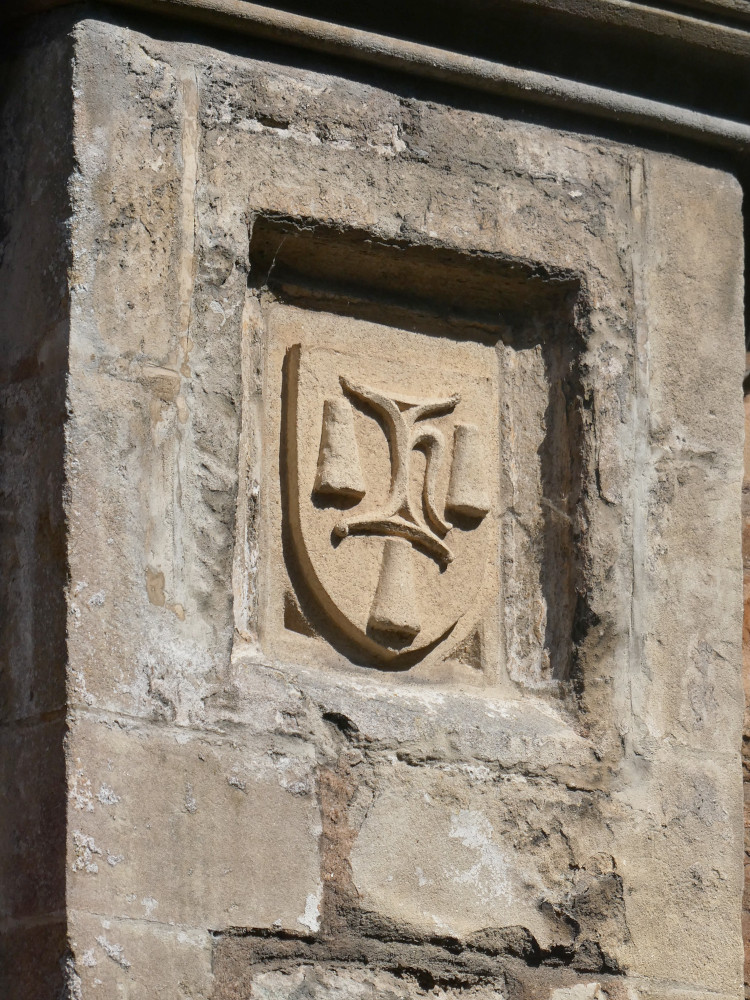
The last thing we saw was an Anthony Gormley sculpture in one of the empty niches on the front of the cathedral and to be honest, I didn’t see it at first. I saw a limestone figurine that looked like most of the others except it looked like it had been sandblasted until it had no features whatsoever. Fits in with the rest but visibly different. It wasn’t until a passing tourist pointed out how ugly the modern sculpture is and how inappropriate it feels to be actually on the cathedral that I realised that in the very next niche there was a kind of human-shaped thing made out of rust-coloured cubes. I was looking practically right at it and never saw it! Well, that’s how intrusive that particular piece of modern art is!

I’ve already rambled incoherently for far too long and honestly, with the amount I learned, I could triple the length of this post but I’ll spare you. Wells still isn’t my favourite cathedral – nothing’s ever going to knock Winchester off – but it’s very interesting and if you take nothing else away from this post, take the fact that a cathedral is a wonderful place to keep cool in a heatwave.